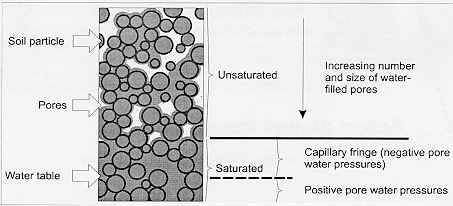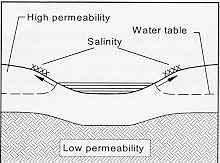| | Problem | Background | Study description | Major findings | Applied questions
Problem
Soil salinity is a serious problem for prairie agriculture, causing reduced crop yields and large economic losses. In east-central Alberta, many saline zones occur as rings of salt around sloughs. The saline ring appears within a few years after the willows and grasses around the slough have been removed. By increasing our understanding of the causes of slough ring salinity, we can find more effective ways to prevent or control them.
Background
Prairie soils have formed on parent materials that naturally contain small amounts of salt. Groundwater dissolves the salts and carries them along as it flows through porous soil or rock formations. Under certain conditions, groundwater rises to the soil surface where the water evaporates, leaving the salts behind. Over time the salts accumulate and a saline seep is formed.
It was originally thought that slough ring salinity was formed primarily through deep, saturated groundwater flows, i.e. water deeper than 1.5 m and which is under pressure and fills all the available pores spaces (Figure 1). At lower elevations in the landscape, the pressurized, saturated flow is able to rise through the overlying material to seep out onto the soil surface. There the water evaporates, leaving the salts to accumulate.
Deep groundwater is replenished by deep percolating soil moisture that has moved down below the root zone in the upland portion of the drainage area. The excess soil moisture in the root zone often results from summerfallow. Research shows that summerfallow on average stores only 25% of the precipitation received during a 20-month fallow period. The remainder of the water either runs off, evaporates or moves below the root zone to add to the deep groundwater.
The purpose of this study was to determine if deep groundwater flow was responsible for the saline ring or if shallower flow processes were more important.
Study Description
From 1992 to 1997, a salinity research project was carried out, using groundwater and contaminant transport models, to simulate the flow of groundwater and salts in various types of saline seeps, including slough ring salinity.

Figure 1. Saturated and unsaturated groundwater
Major Findings
This research study was able to determine the proportions of the different flow components contributing to saline seep formation. Shallow groundwater was found to play the major role in the formation of slough ring salinity.
Shallow groundwater flows laterally from ponds or sloughs through the near-surface sediments towards zones of high evapotranspiration. It moves as unsaturated flow. In unsaturated flow, some of the biggest pores are empty, and the flow occurs only through the remaining smaller pores. Small pores retain water better than large pores because of the surface tension effect.
The surface tension effect is very common in our experience. We simulate the stronger water retention in small pores when we place a straw in a glass of liquid. The upper surface of the liquid in the straw rises above the surface of the liquid in the glass because of suction under the meniscus caused by surface tension. The smaller the straw diameter, the higher the suction and the higher the liquid goes up the tube relative to the level of the liquid in the glass. Small diameter pores, whether in a straw or in the soil, generate the same type of suction. The smaller the pore diameter, the more suction is generated. Similarly, the smaller the pore, the harder it is to draw the water out and so large pores will empty first. Because sandy soils tend to have larger pores, they do not hold water but let it percolate on down, and thus hold very little water during dry times.
The top 1 m of soil is also very permeable, because of decaying crop roots. Crops put down many roots in the course of a growing season, some large and easily visible in the soil and others very fine and nearly invisible. This rooting system increases the soil's capacity to transmit water, especially when the soil is wet.
Under natural conditions, there is a plant community consisting of willows, bullrushes and other plants around the slough. This plant community is called phreatophytic vegetation. Transpiration from the phreatophytic vegetation is responsible for up to 90% of the water loss from a slough. Water loss from the actual slough surface can be quite small. Around the slough, the soil is wet and many of the root holes and larger pores are filled with water which can thus be transmitted to the roots of the transpiring phreatophytic vegetation.
Removal of the phreatophytic vegetation can lead to slough ring salinity. The removal of the vegetation eliminates the transpiration from these plants, leaving more water in the slough which leads to increased shallow groundwater flow from the slough.
In addition, conversion of the upland from prairie grass to a crop/fallow system increases runoff from the land to the slough, adding more water to the slough and more potential for salinization.

Figure 2. Slough ring saline seep formation
Although the phreatophytic vegetation is removed, the cropped areas near the slough are still transpiring and still in need of water. When the crops remove the water from the soil, they set up a zone where the suction is greater than near the slough. This suction causes shallow groundwater to flow from the slough through the permeable soil layer towards the evapotranspiration zone (Figure 2). As the groundwater moves through the soil, it dissolves and picks up salts. On its way upslope towards the cropped area, the salty groundwater is also pulled to the surface by evaporation.
Most of the evaporation and surface salt accumulation occurs at elevations less than 1 m above the slough because there is a limit to how far upslope the water and salts can move. With increasing distance from the slough, fewer and fewer of the large pores and root channels contain water. Eventually, so many are empty that little of the shallow groundwater can move any farther.
Applied Questions
How quickly do slough ring saline seeps form?
Slough ring salinity is very dynamic. Saline rings can develop around prairie sloughs within three years of the removal of the willow rings, bullrushes and other vegetation around the slough.
How can farmers prevent slough ring seeps?
The best way to prevent slough ring salinity is to leave intact the willow ring and associated vegetation around the slough. These plants prevent slough ring salinity by intercepting the shallow groundwater that tries to move from the slough towards the cropped upland area.
How can farmers control or reduce existing slough ring salinity?
Farmers can plant salt-tolerant perennial grasses in a band around the slough in the visibly saline area and extending an additional 20 to 60 m beyond. The grasses will partially replace the natural vegetation, thereby reducing the flow of shallow groundwater from the slough towards the surrounding cropland. Avoiding cultivated fallow on the surrounding land will also help because cultivated fallow results in increased runoff to the slough and increased potential for salinization.
Return to CAESA Soil Quality Program Research Factsheets
This information is provided by W.J. Stolte, University of Saskatchewan, Department of Civil Engineering, Saskatoon, Saskatchewan. |
|